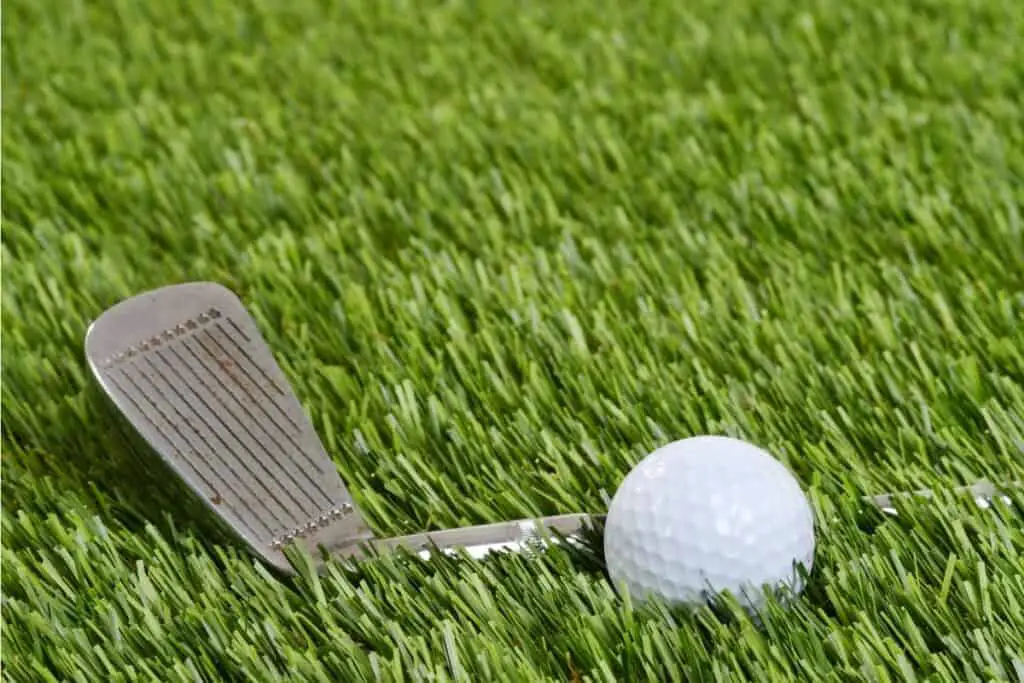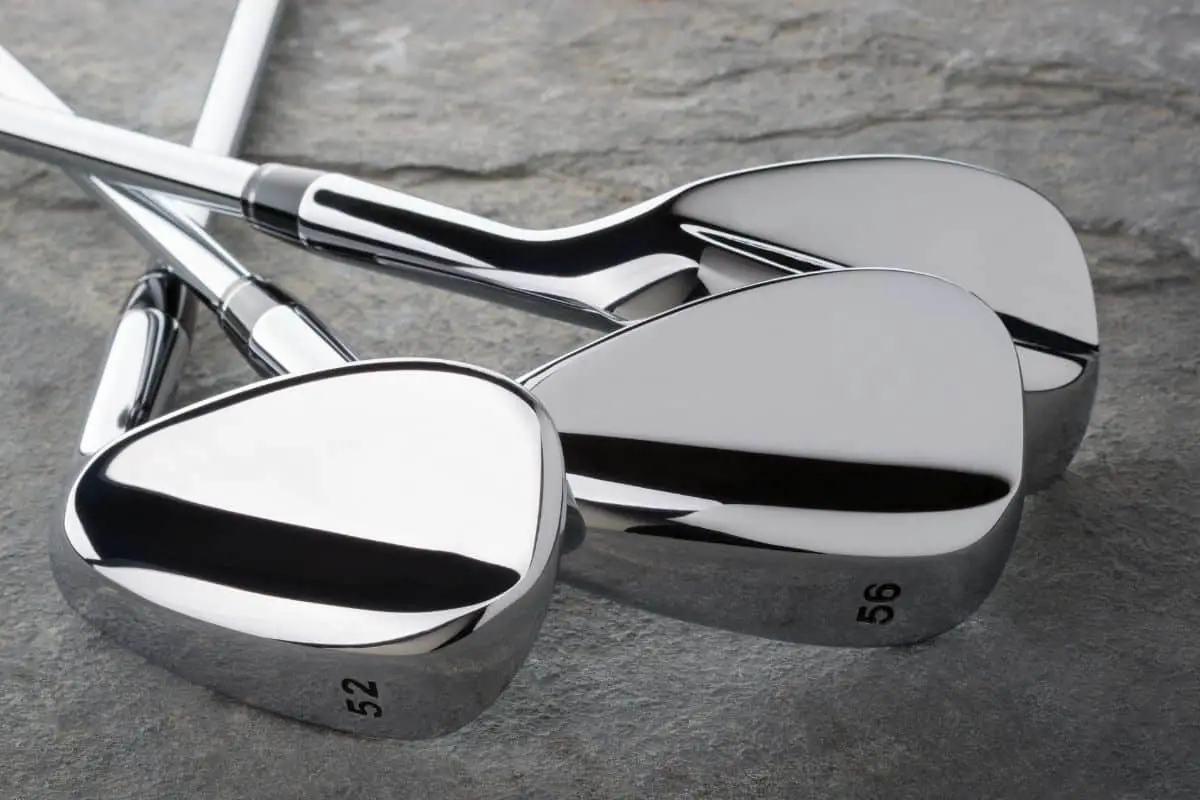The loft of a wedge is the angle of the club verse the ground. The more angled away from 90 degrees, the higher the ball will launch.
And knowing what loft is best for you is important when building your set of clubs.
Hopefully our guide on wedge lofts will provide you with all the info you need to get started!
Wedge Lofts

Although iron and wood clubs have a pretty high loft, wedges are the most lofted of all the golf clubs, having a greater degree of loft than both.
Most iron sets will feature a pitching wedge, and the vast majority of them will also include a gap wedge as an optional extra (sometimes known as an approach wedge or A-wedge).
In most cases, these wedges will be utilized for shots that need a whole or almost complete swing, so think of them as your 10-iron and 11-iron, respectively.
As part of the design process for an iron set, manufacturers will construct the pitching wedge (PW) and a gap wedge (GW) with lofts that will produce the best yardage gaps feasible with the set’s 9-iron.
A sand wedge and a lob wedge are two clubs that are rarely featured in golf set bundles.
If you are looking to buy a complete set of clubs and want both the lob and sand wedge as well, you will have to double-check that these are included in the purchase.
The majority of the time, you’ll be utilizing your sand wedge and/or lob club to hit shorter shots around the green and out of bunkers on your golf course.
The vast majority of golfers choose to use these wedges on their own to ensure that they are tailored to the individual demands of the player as well as the conditions of the courses that they frequently visit.
Pitching Wedge
When measured in degrees, what is the loft of a pitching wedge?
These days, the loft of a standard pitching wedge (PW) ranges from 45 to 47 degrees.
In comparison to iron sets designed primarily for inexperienced golfers, which are referred to as game-improvement irons, more traditional clubs have lower (stronger) lofts.
Pitching wedges with lofts as low as 43 or 42 degrees, when used along with a game-improvement iron set, can assist golfers to maintain distance gaps when compared to their heavier lofted 9-iron.
Intermediate golfers will typically use a pitching wedge with a higher loft, often 46 or 47 degrees, and setups for the top players will be in the middle of those two extremes.
Gap Wedge
In most cases, a gap wedge (GW), is often referred to as an approach wedge (AW), A wedge, or an attack wedge. It is designed to have a loft of 50 to 52 degrees.
Like in previous examples, the loft of your gap wedge is dictated by your iron set. In some cases, gap wedges with as little as 48 degrees of the loft are available in game-improvement-oriented iron sets.
In the case of a pitching wedge or a gap wedge, the most important thing you want from these clubs is correct yardage gaps when your 9-iron is too much for the circumstances.
Sand Wedge
Golfers often use a wedge with a loft of 54 to 58 degrees, which is somewhat higher than the average 56-degree loft of a sand wedge (SW) on the course.
The majority of iron sets do not contain a sand wedge as standard equipment. If you do not have this wedge in your set, you can try to use one with a similar grind, loft, and bounce.
However even if the wedges are very similar, the sand wedge will always work best.
It’s usually more important to be able to use your sand wedge well for shorter partial shots around the green and bunker shots than it is to be able to use your other clubs, such as your PW and GW.
Many players refrain from completing full swings when they reach their highest wedges because these kinds of shots are tough to do consistently with the club in their hands. Instead, some golfers will employ 1/2 or 3/4 swing strokes with smaller lofted wedges (like Gw and Pw) to hit their targets more effectively.
Lob Wedge
A lob wedge is the golf club with the maximum loft, and it is also the club that is most frequently utilized on the course.
A standard lob wedge (LW) is described as one with a loft between 58 and 64 degrees angles, with 60 degrees being the most common angle of the loft.
When compared to sand wedges, lob wedges are even more specialized in their use, since they are employed for shorter strokes around the green and bunker shots, rather than all shots.
It works especially well when you need to get the ball in the air quickly (for example, over a bunker lip) and have it come to a halt on a green in short order (short-sided shots).
While some golfing professionals use wedges with exceptionally high lofts (up to 64°), the average golfer will typically struggle to hit anything with more than 58 or 60 degrees of loft regularly.
Summary
Wedges are vital to any golfer’s kit, whether they are a beginner or pro. They can significantly enhance your golding games, making your scores much better than they would have been before.
If you don’t have any of these in your kit yet, you should maybe buy one just to test it out and see if you like to use it.
Frequently Asked Questions
Why Is The Distance Gaps Of Clubs Important?
When choosing a driver, your priority should be driving the ball as far as possible while retaining good control of the ball.
The club becomes substantially more crucial after this point, and hitting clubs consistently at great distances becomes significantly more important rather than hitting just a few of them pretty far away.
To maximize the distance between their clubs, clubmakers and club fitters employ lofts and shaft lengths to get the best possible results.
Using a club with more loft will cause the ball to be sent higher into the air, limiting the distance it can travel before striking the ground.
Specifically, your set of golf clubs will be built so that the yardage gaps between the irons and wedges provided are appropriate for your level of play.
You should consider the distance you hit your higher lofted wedges in relation to the highest lofted club in your set when deciding on which ones you should take to the course with you.
Even though this is critical for whole shots, it is also very important for longer partial shots (3/4 to 1/2 swings) as well.
You’ll want to make certain that your highest lofted wedges are available for users around the greens and out of greenside bunkers to maximize your scoring potential.
Wedges – How Many Do I Need?
Three wedges are more than enough for beginners. A pitching wedge and a gap wedge will be necessary for distance gapping, as will a 54- to 56-degree sand wedge.
If you’re utilizing heavily lofted game-improvement irons, a 54-degree wedge should be a better alternative because of the yardage difference. As a general rule, you should strive for a loft difference between wedges of no more than 4-5 degrees.
Before discussing the fundamental wedge needs, it’s vital to keep in mind that your bag is limited to 14 clubs. This means that you will frequently have to choose between boosting or reducing your lofted clubs.
Even the best golfers in the sport carry a range of wedges.
Carrying a lob wedge makes significantly more sense for more skilled golfers than it does for beginners. Superior golfers will find this club effective around the greens, but longer hitters may require a 58 to 60-degree club for yardage gap reasons.
The optimal setup for you also depends on your predilection for shorter-length shots and the degree to which you have mastered the half swing game.
- Should Tee Boxes Be Level? - January 23, 2024
- 3 Hybrid Distance - November 15, 2023
- Innovations in Golf Mobility: An In-depth Review of Top Golf Scooters - October 12, 2023
